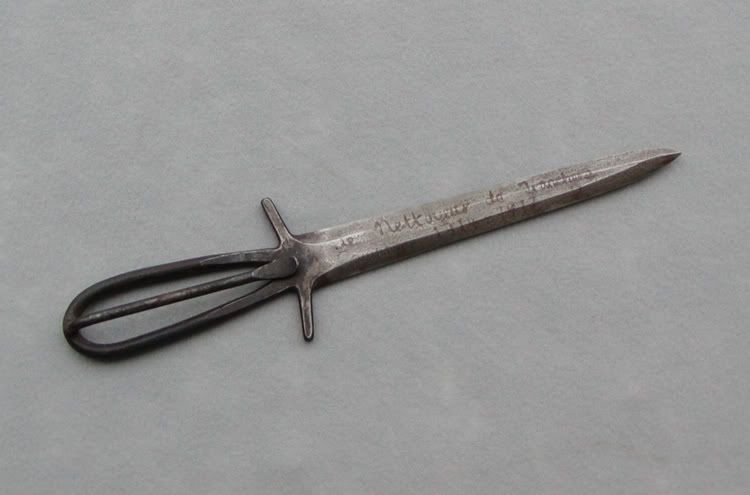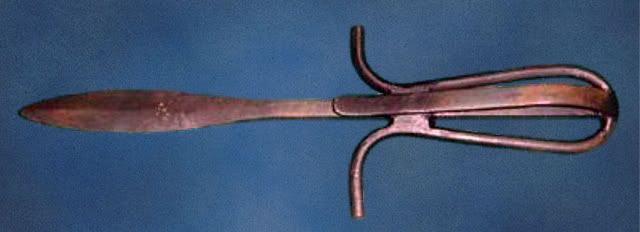
 |
|
|
#1 |
|
Member
Join Date: Jan 2006
Location: Kent
Posts: 2,658
|
A crude (read 'undecorated) looped handled curved dagger just finished on eBay....certainly not a high end piece ..but has functional charm.....missed the auction otherwise it might have ended up living with me.
I like this type of weapon....no pretentions , just functional. Seems to have some age, I think the stated origins are unlikely, especially the reference to the 'Thugees' whom strangled their victims not stabbed them. I wondered if anyone had any ideas. Was thinking some sort of well made 'village' piece? http://cgi.ebay.co.uk/ws/eBayISAPI.d...MEWA:IT&ih=012 Thanks David |
|
|

|
|
|
#2 |
|
Member
Join Date: Jun 2006
Posts: 179
|
I was looking at that one too. I thought it might be tool. Or, it might be a crude bichwa.
Shawn |
|
|

|
|
|
#3 |
|
Member
Join Date: Jan 2005
Posts: 478
|
I don't know. It looks to me like something a blacksmith would do to amuse himself or test his skill. I have seen railroad spike knives made in the same vein. I have also seen cable knives where cable is welded and a blade formed from it leaving the strands to show. It could be genuine but similiar types exist with no fancy story behind them.
|
|
|

|
|
|
#4 |
|
(deceased)
Join Date: Dec 2004
Location: East Coast USA
Posts: 3,191
|
I agree with Mross a blacksmith special.
Lew |
|
|

|
|
|
#5 |
|
Member
Join Date: Dec 2007
Location: Portugal
Posts: 50
|
Maybe a "blacksmith knife" like this one...or
 just a knife with a viking design just a knife with a viking design
|
|
|

|
|
|
#6 |
|
Member
Join Date: Nov 2004
Location: USA
Posts: 1,725
|
I agree--modern made blade. Looks pretty cool.
|
|
|

|
|
|
#7 |
|
(deceased)
Join Date: Dec 2004
Location: OKLAHOMA, USA
Posts: 3,138
|
IT REMINDS ME OF THE VARIOUS SIMPLE FORMS OF WEAPONS MADE BY PRISONERS KNOWN IN THE USA AS SHIV'S. THEY CAN BE MADE FROM MOST EVERYTHING FROM A NAIL, BONE, CAN, GLASS OR A PIECE OF SILVERWARE.
BUT IT LOOKS TO HAVE BEEN FORGED WHICH WOULD BE VERY UNLIKELY IN PRISON SO I WOULD ALSO SUSPECT IT TO BE A SIMPLE KNIFE MADE BY A BLACKSMITH. |
|
|

|
|
|
#8 |
|
Member
Join Date: Jan 2006
Location: Kent
Posts: 2,658
|
Thanks Gentlemen
 , ,I suspected as much....still it does have a certain amount of 'charm'. The blade seems to be reasonably well made/forged . Regards David |
|
|

|
|
|
#9 |
|
Member
Join Date: Dec 2004
Location: Ann Arbor, MI
Posts: 5,503
|
Another one that comes to mind is a medieval Dussack: a simple and cheap sword-size weapon used by the Czech Hussites. It absolutely required a heavy leather glove.
|
|
|

|
|
|
#10 |
|
Member
Join Date: Dec 2004
Posts: 1,247
|
Couple of modern traditional blacksmiths make a knife that's combined with a flint striker. That's what this one looks like.
F |
|
|

|
|
|
#11 |
|
Arms Historian
Join Date: Dec 2004
Location: Route 66
Posts: 10,602
|
Looks a lot like an old dussage! and it seems like these were some sort of blacksmith test item. The far fetched description on the item is incredible! It seems that often the 'thuggee' term is dragged out and used as a colorful term by people who have no knowledge on this cult whatsoever. The thugs only specific weapon was actually a ceremonial axe used for burials. Of course there may have been other weapons used, but nothing distinct and depended on local weapons in the area.
|
|
|

|
|
|
#12 |
|
Member
Join Date: Oct 2007
Posts: 2,818
|
Maybe someone can bring them to light but weren't there simple trench knives made in the world wars that followed a simple pattern similar to this??
regards Gav |
|
|

|
|
|
#13 | |
|
Member
Join Date: Jan 2005
Posts: 478
|
Quote:
|
|
|
|

|
|
|
#14 |
|
Member
Join Date: Mar 2006
Location: Room 101, Glos. UK
Posts: 4,252
|
trench knives encompass a wide variety of issue and improvised weapons used for close hand to hand fighting in the ww1 trenches. this (attached) is a screen dump from http://www.snyderstreasures.com/page...kle_knives.htm which shows quite a variety including the french nail knives. german grabendolch trench knives were usually a bit more conventional spearpoint blade, short or long giard, wood scales, steel scabbard with leather blet loop, etc. no knucklebows...
another more elaborate french nail version, smith had time to forge a real blade on this one. i've seen them with similar triple rod hilts and the more common rough spearpoint-like nail blade. repro's abound so caveat emptor. 
Last edited by kronckew; 18th June 2008 at 09:47 AM. |
|
|

|
|
|
#15 |
|
Member
Join Date: Jan 2006
Location: Kent
Posts: 2,658
|
Great info Kronckew
 , ,trench made knives and daggers fabricated 'in field' were very varied. Made for use, in what was known as 'trench clearing'  the majority I have seen tend to be stabbing impliments, with simple needle/stiletto blades. Easily made and effective. the majority I have seen tend to be stabbing impliments, with simple needle/stiletto blades. Easily made and effective.What struck me about the 'knife' which started the thread, is the deliberate curve of the blade. It seems idealy suited for slashing, and with a shortish blade suggested it may have required some skill to use (if it is indeed a weapon). I was thinking it may have been used in a similar way as the Indonesian Karambit, perhaps in pairs, one in each hand (been watching too many martial art films I suppose  ) )I suppose this could be a tool, but seems to small for an agricultural tool (although I believe the Karambit started life as a 'crop cutter') or effective as a wood working tool.  Having said all that, I hope I'm not going down the 'same road' as I did with my 'deadly' Asparagus Spear.....eh Kronckew Having said all that, I hope I'm not going down the 'same road' as I did with my 'deadly' Asparagus Spear.....eh Kronckew  http://www.vikingsword.com/vb/showth...ight=asparagus Regards David |
|
|

|
|
|
#16 |
|
Member
Join Date: Mar 2006
Location: Room 101, Glos. UK
Posts: 4,252
|
reminds me a bit of this viking ''woman's knife''
 yours is just a bit more macho. possibly grip/ grip-blade angle has been bent a bit more than when 1st made? i suspect that when the blade was forged single edged it naturally formed a curved blade as the edge was hammered thinner the displaced metal bends the spine. double edged and spear point variants do not have that problem (or feature). somebody wanted a slicer rather than a thruster. (still might be a victorian gardening impliment  ) )
|
|
|

|
|
|
#17 |
|
Member
Join Date: Mar 2006
Location: Room 101, Glos. UK
Posts: 4,252
|
shortly after the above, i found this one on ebay:
 as i didn't have one, it's now mine. |
|
|

|
 |
|
|